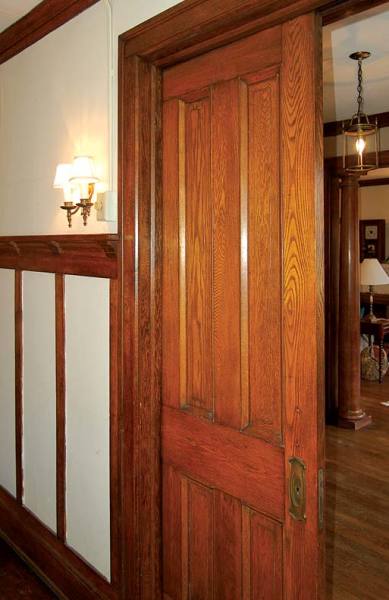Pocket doors make an elegant, versatile statement that is unique to old houses.
Few things are more elegant—and elusive—than the smooth roll and click of pocket doors in perfect working order. Some old-house owners never have a moment’s trouble with their pocket doors; others struggle with doors that stick, balk, bind, scrape, gap, make noise, or won’t move at all. Before you begin to troubleshoot your pocket door problems, determine what kind of doors you have.
Pocket doors come in two basic types—floor-track and top-hung. More common in mid-19th-century houses, floor-track doors roll in and out of their pockets on sheaves, or rollers, that ride on a metal track. The track is usually recessed into the floor, although sometimes the track rests directly on the surface.
Late in the 19th century, top-hung doors superseded the floor-track type. In top-hung doors, the carriers containing the rollers, or wheels, run in an overhead track in a recess above the doorway soffit designed for the purpose. Top-hung doors are far more common than floor-track doors.
Thanks to a proliferation of pocket-door hardware manufacturers in the late 19th century, the mechanisms vary more than those for floor-track doors. That said, there are three basic types: single roller, double roller, and trolley style. By shining a flashlight up into the track above your doors, you should be able to tell which of the three types you’ve inherited.
Floor-track and all three types of top-hung doors tend to suffer from the same sorts of problems—sticking, warping, rolling too far or not far enough, and damaged or missing rollers or tracks. In many situations, the solutions are the same, even if the mechanisms that control movement differ.
Many of the clearances around a smoothly operating pocket door are only about 1/4″. If your doors stick, balk, or refuse to come out at all, building settlement is probably to blame. Begin with the obvious: If your house has had a lot of alterations, the doors could be nailed in place or sealed up. Look for nails through door edges or a stop piece or furring strip nailed across the door opening. Next, use a flashlight to check for broken plaster or other debris inside the door pocket. Floor-track doors that refuse to budge may have jumped the track. Lift and rock the door to get it back on track. Floor-track doors also have a guide pin that slides in a slot at the top of the door. If the door has slipped off the pin, wiggle the door around to get it back on center.
If a top-hung door is balky, it may be binding either on the track above or on the floor below. Fortunately, the height of the rollers is adjustable. Locate the slanted screw mechanism on top of the door just inside the recess area. If the door is scraping against the floor, turn the adjustment screw so that it pulls the door upward. Tap some shims under the door to hold it about 1/4″ off the floor. After you’ve raised the door and removed the shims, make sure the door hangs at least 3/16″ off the floor. If the door is too high, adjust the screw to lower it. Be careful not to unscrew it completely, however, or the door will fall off!
As buildings settle with age, floors have a tendency to bow in the middle or at the edges of a room. Both conditions can cause your pocket doors to gap when closed, especially if they’re floor track. You can help your doors hang straighter by shimming under the track.
If a top-hung door gaps, check to see that the roller mechanism is securely fastened to the top of the door and that the door itself is not warped. Adjusting the roller height may help alleviate the problem. The stop moldings along the side jambs or along the top track may be loose or warped; carefully remove them and re-nail them in the correct alignment.







